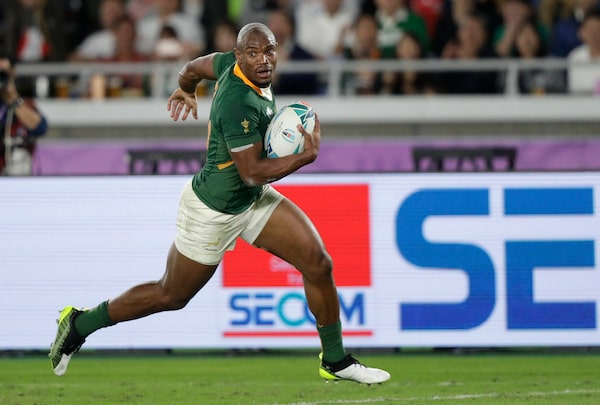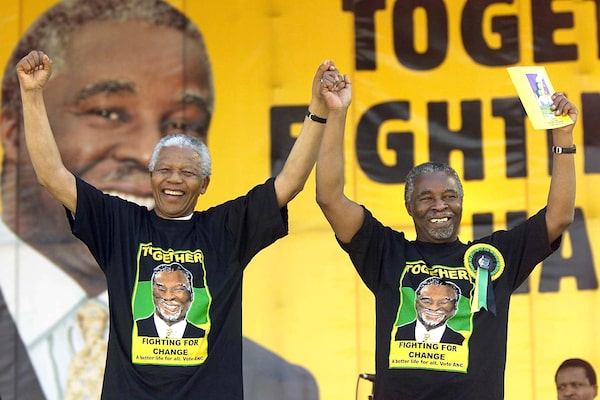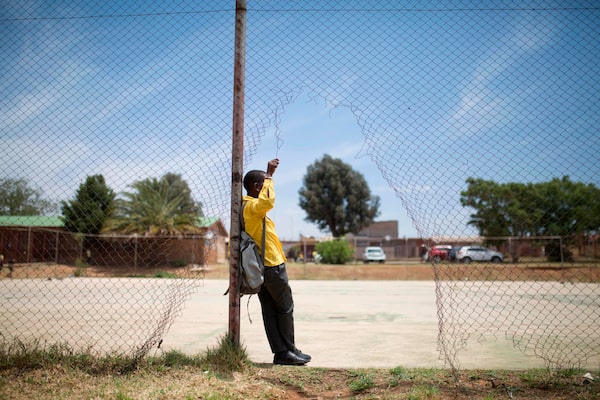Siya Kolisi hoists the Webb Ellis rugby trophy after South Africa's World Cup win in Yokohama on Nov. 2.Matthew Childs/Reuters
Richard Poplak is a Canadian author and journalist based in Johannesburg. He is currently working on his first documentary, Influence.
The greatest moment in South African sports history occurred about 66 minutes into the 2019 Rugby World Cup final match, which unfolded in all its gore-drenched glory in Yokohama, Japan, early last month. The moment was almost impossible to process in real time. It was performed by winger Makazole Mapimpi, who chipped the ball over a advancing wall of English players as he roared toward the try line. It was picked up by Lukhanyo Am on the inside, who sent an insouciant no-look pass into the arms of the winger. Mr. Mapimpi pronked his way home with the grace of the leaping antelopes that give his team its name – the Springboks.

Makazole Mapimpi runs to score a try.Mark Baker/The Associated Press
I should get one thing out of the way before we go any further: The game was the most perfect 80 minutes of sports I have ever watched in my lifetime. Repeated viewings have not only upheld this conviction, but enhanced it.
There was none of the usual cynicism that attends major finals, nor the chintzy pragmatism that comes with so much pressure and expectation. The Springboks met a very good English side and delivered a match that was brutal in its simplicity – picture Marie Kondo emptying a closet with a grenade. No one moaned about the officiating; there were no Phil Esposito-ish throat-slashing gestures. It was the purest final ever played on a major stage.
In addition to the on-field heroics, the game was rife with the sidebar narratives that turn sports writers into bad poets and worse oracles. What, the wags wondered, did the game mean? Was the 2019 national side a reflection of South Africa in the 21st century, a country turning the corner on racial divisiveness and institutionalized inequality? Or was it just another circus, sans the carbs?
Mr. Mapimpi and his teammates celebrate after scoring their first try.Peter Cziborra/Reuters
Before the first magnum of champagne was swilled, the arguments began to rage.
Like everything in South Africa, rugby has a racial component: Most people consider it a game played and watched by white people. Over the years, there have been many attempts at “transformation” – local parlance for the policies that compel corporate and sporting institutions to better reflect the demographics of the country. For instance, while the white minority comprises less than 8 per cent of the population, they still dominate Springbok caps, to say nothing of corporate leadership positions, the media and the economy in general.
Could the Springboks fix this?
Well … maybe? Mr. Mapimpi, the since-beatified try scorer, is a product of the wretchedly governed province of Eastern Cape. He was brought into formal rugby structures relatively ancient, in his late teens, and thrived. Was he on the team because he was brilliant, because of affirmative action – or both?
More important, at least as far as South Africa boosters were concerned, the side was captained to victory by a black man. Siya Kolisi, a superb athlete and leader, was raised in poverty to become an international sporting icon. (Widely circulated representative anecdote: He grew up without a TV and was forced to watch the 2007 World Cup finals in a tavern.) Bonus points for the fact that, like many South Africans at the peak of their careers, he has refused to engage in the politics of division. We are stronger together, Mr. Kolisi kept insisting, his loving multiracial marriage serving as an exemplar.

Siya Kolisi and Archbishop Desmond Tutu wave alongside a statue of ex-president Nelson Mandela in Cape Town during the rugby team's championship tour on Nov. 11.Ashley Vlotman/Ashley Vlotman/Gallo Images/Getty Images
South Africa’s primary contribution to the fourth industrial revolution is a roaring trade in hashtags and memes. With help from the Springboks’ mighty corporate sponsors, #StrongerTogether started circulating on social media, with predictable results. Conservatives, for the most part representing minority interests, conveniently forgot that the multiracial team was a product of affirmative action and pointed to its plurality as proof that the country no longer required affirmative action.
The radical left insisted that #StrongerTogether was nothing more than corporate brainwashing – that black people had no part celebrating a team that had always been used to paper over systemic inequities. They had a point: The 1995 World Cup final, the most famous rugby game of all time, was a clunky, low-scoring turf war between the New Zealand All Blacks and the Springboks. Nonetheless, it was adapted into the 2009 Clint Eastwood film Invictus, in which Morgan Freeman plays Nelson Mandela and the unifying nature of sports is celebrated. Much sap flowed with the blood, sweat and tears.
Johannesburg, 1995: Mr. Mandela give the Webb Ellis trophy to Springbok captain Francois Pienaar after his team defeated New Zealand in the rugby world final.Reuters
Still, Mr. Mandela was a master of political symbology. In 1995, with the country still on the brink, he employed the Springbok victory to forge his “Rainbow Nation” rhetoric – the #StrongerTogether of a simpler time. Mr. Mandela was a firm adherent of non-racialism, believing that South Africa’s diversity was its strength. In order to avoid interminable civil conflict, he insisted that all South Africans were equal before the law. By elaborately and performatively forgiving the old oppressors, he would father a cohesive country into being. The Truth and Reconciliation Commission, which unfolded in the mid-nineties, puked up apartheid’s dark intricacies, but none of the death-squad assassins or army generals ever faced a firing squad. Instead, their confessions were traded for amnesty, and they were absorbed into the new state.
The first free elections in 1994, it was hoped, would usher in normalcy – whatever that meant. Instead, it was the first step on the road to a brutal realization: Political enfranchisement is useless without economic freedom. In the negotiated settlement that ended apartheid and outlined the terms for democracy, the conservatives within the governing African National Congress assumed that if the economy was left intact – in other words, if the white minority’s assets weren’t stripped and redistributed to the black majority – and liberalization were to occur, the resulting stability would trickle down to the tens of millions marginalized by the previous regime. With their former Soviet sponsors resoundingly defeated, and with even the Chinese Communist Party embracing the wisdom of market capitalism, the ANC had no choice but to promulgate a Western-style political economy. Welding such an arrangement to a violent country, in which the majority were dispossessed of their land and deliberately kept in penury, was not so simple.

Soweto, 1999: Mr. Mandela greets the crowd alongside Thabo Mbeki, his deputy and soon-to-be-elected successor as president.ODD ANDERSEN/AFP/Getty Images
The solution, spearheaded by Mr. Mandela’s successor, Thabo Mbeki, was a two-flank attack. First, South Africa would institute a massive social grant program for the poor. (There are currently 17 million recipients, the largest in the world.) Second, serious black advancement would accrue to an elite connected to the ANC, who would access the fruits of economic empowerment policies that carved up chunks of corporate ownership for black partners.
Even in theory, this seemed vastly unsound – it appeared to be little more than a Band-Aid over the systemic deficiencies of colonialism. But in practice, the results were nothing short of catastrophic. First under Mr. Mandela, and accelerating under Mr. Mbeki, the ANC became one of the world’s most efficient looting machines. By the time Jacob Zuma rose to power, the state was under siege from entrenched, semi-official thievery. But Mr. Zuma’s corruption was performed in another register. It was his aim to destroy almost all state institutions while placing the security apparatus under his control. By some estimates, more than $150-billion was leeched from the country in the latter half of his nine-year tenure, which ended in February, 2018.
Pretoria, 2019: President Cyril Ramaphosa, head coach Rassie Erasmus and Mr. Kolisi lift the trophy at a stop on the championship tour.Mike Hutchings/Reuters
Mr. Zuma was replaced with Cyril Ramaphosa, perhaps the most famous beneficiary of economic empowerment. A former trade unionist-turned-billionaire, Mr. Ramaphosa is a genial plutocrat who came into power promising a #NewDawn. Turns out it’s far easier to break a country than to fix one. His term has been dogged by a shrinking economy and a faction within the ANC that refuses to co-operate, with the party locked in an internecine war from which there are unlikely to be any clear winners. Saddest of all, between the 1995 and 2019 World Cups, while the entire world has been flipped on its head, South Africa remains mired in a bog of apartheid-era social and economic dynamics.
On Nov. 14, Statistics South Africa and the South African Labour and Development Research Unit released a report called “Inequality Trends.” As things stand, the top 1 per cent of South African earners reaped almost 20 per cent of all income in the country. The top 10 per cent hoovered up 65 per cent, which means a whopping 90 per cent of South African earners were left with the remaining 35 per cent.
Between 2011 and 2015, white people earned around $2,500 a month on average, while black people earned less than $700. Women earned 30 per cent less than their male counterparts. Earnings at the very top grew by 15 per cent. Earnings at the bottom shrank by more than a quarter. Worse, the 1 per cent hold 67 per cent of the country’s wealth, while the bottom 90 per cent own just 7 per cent. Meanwhile, the unemployment figures look like typos: Just less than 30 per cent of the country can’t find work, with almost 60 per cent of young people locked out of the job market.

Members of the Congress of South African Trade Unions hold a demonstration in Durban on Feb. 13.RAJESH JANTILAL/AFP/Getty Images/AFP/Getty Images
Those numbers are about to get worse, as the Ramaphosa government struggles to keep state-owned enterprises afloat. The national airline is no longer a viable business, and the power utility, Eskom, owes creditors more than $35 billion and is not earning enough revenue to service its debt. Tens of thousands will need to lose their jobs in order to make these companies sustainable, which means a war with unions that have been bleeding members for years.
#StrongerTogether? Not so much. But can the Springboks teach South Africa, and perhaps the world, anything about climbing out of the mire? It’s safer to steer clear of the poets and oracles, but it is worth noting that transformation can usher in moments of staggering brilliance, to say nothing of fairness. Very simply, if South Africa doesn’t reconfigure itself to bring everyone onto the economic pitch, the country will fail, and all of its initial promise will be squandered. We are moments away from the final whistle. Time for a no-look pass.

A student at the Soweto Rugby School Academy rests before practice on Nov. 6.GUILLEM SARTORIO/GUILLEM SARTORIO/AFP via Getty Images